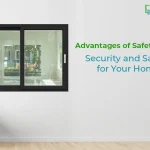
Advantages of Safety Glass: Security and Safety for Your Home
October 24, 2024
uPVC villa window: What are they and how they improve the look and feel of your villa?
October 25, 2024Safety glass window is an important feature in a home, increasing protection, cutting on the risks of injury, and raising the safety levels of your property. You took some time to think about getting some safety glasses for your home. Great. And here are a few best practices and very important considerations to be in the know about.
What is the Safety Glass?
Safety glass is manufactured to avoid injury upon breaking. So it will break in the form of small, blunt pieces instead of razor-sharp, dangerous shards that regular glass would produce. The two basic kinds of safety glass are tempered glass and laminated glass.
Tempered Glass
Tempered glass is heated and then suddenly cooled by blasts of air, making it far stronger than ordinary glass. It shatters into little, non-lethal pieces.
Laminated Glass
This only refers to two or more glasses with an interlayer of plastic material enclosed between them. The plastic attached to the glass keeps the pieces together, hence, it cannot let them fall freely, even if the glass is broken.
Recommendations for the Installation of Safety Glass
Take appropriate measures and plans
Take measurements of a window or door size where you plan to fix the safety glass. Correct measurements also avoid cracking and save you from accidents.
Choose the Right Type of Safety Glass
You can choose among the different safety glasses depending on the functional requirement of an area. For example, toughened glass is suitable for areas that require impact resistance, face extreme weather, or have high foot traffic. Similarly, laminated glass makes a great choice for areas requiring good sound insulation, security and UV protection.
Hire a Professional Installer
As much as DIY is associated with fun and cheap projects, the installation of safety glass is all about precision and expertise. Hiring an expert to do the work will, therefore, ensure that your glass installations are done right.
Use Appropriate Tools and Equipment
If you decide to fix it, be sure to have the right tools: a pair of suction caps, safety gloves, and goggles. These facilities enable you to handle the glass properly, avoiding any major risks to your health.
Seal Properly
Once the glass is fitted, remember to seal it. Use high-quality caulk or sealant on the edges to prevent drafts and water leaks, which can degrade the quality and purpose of the installation.
Considerations for your home
Energy Efficiency
Safety glass can also be installed in windows in your home in order to increase their energy efficiency. This means that laminated glass, especially, is better insulated and, hence, maintains your home's temperature at cooler points during the hot summer months and vice versa for winter. Low-E coatings can also be applied to these glasses to further improve the energy efficiency.
Maintenance
Safety glass cleans with little effort. Use a soft, clean cloth and mild soap for cleaning to wipe off smudges and dirt any time one desires to keep its clarity and beauty. Cost Even though you will pay more for safety glass, the difference or added value immediately comes to market in the attached security and comforting peace of mind. Get several quotes for price comparison.
Conclusion
Households with added toughened glass window increase the house's safety, security and overall value. With the above mentioned practices and considerations in mind, you will have the assurance of a successful installation that will yield durability. Whether you choose to hire a professional or take on the project yourself, safety glass is a worthwhile investment for any homeowner.
Discover GreenFortune, Your Partner in Quality uPVC Windows and Doors
At GreenFortune, we are proud to offer high-quality uPVC windows and doors at affordable prices. We offer and install a variety of window types for all homes with both durability and aesthetics in mind.
Contact us to find out more about the uPVC window design that we offer. Whether you are renovating your existing home or building a new one, partner with us to elevate the comfort levels and energy efficiency in addition to the style quotient of your space provided by our superior-quality uPVC windows.
Frequently asked questions
1. What is the difference between tempered glass and laminated glass?
Tempered glass is much stronger than regular glass due to the process it undergoes during its manufacture, where heating and rapid cooling produce much harder glass. If it were to break, it would shatter into very small pieces with dulled edges that reduce the danger of serious injury; hence, it is ideally applied to places that need added strength, such as sliding doors and windows. Laminated glass has two or more layers of glass with a plastic interlayer. When broken, the plastic layer holds together, and one does not fall apart. This type of glass offers additional noise reduction-related functionalities and value-added functionality regarding UV protection, therefore being suitable for windows opposite busy streets or other areas where one might require added security insofar as windows are concerned.
2. Can I install safety glasses myself, or should I hire a professional?
While installation of safety glass by yourself is possible, due to the required precision and skill, general advice would be to have a professional do it. The professional will ensure correct measurements and fitting that remove the risk of installation errors. They deal safely with the glass using specific tools and techniques so that they do not hurt themselves or cause damage. Furthermore, such professionals are conversant with building codes and regulations in your area; therefore, they will ensure that what you do is legal.
However, if you're going to do it yourself, be sure that you have the right tools and follow all the safety precautions.
3. How to maintain and clean the safety glass?
Cleaning and maintaining safety glass is relatively easy. Wipe it clean using a soft cloth and mild soap; avoid harsh acids or cleaning products and rough materials that scratch the surface. Check periodically along edges and seals for any signs of wear or damage, as proper sealing is crucial to prevent drafts and intrusion of water. Though safety glass is hard, do not hit it with any hard objects because it will crack or break. Following these maintenance guidelines will keep your safety glass clear and in good working order for years to come.







